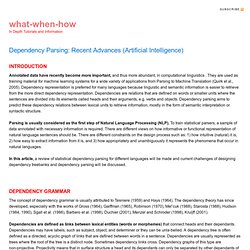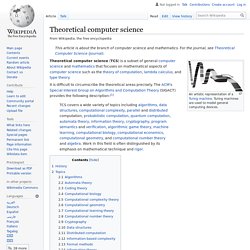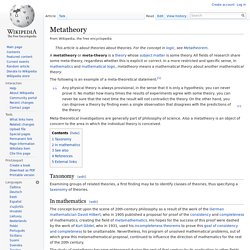

Research news and events on Artificial intelligence research focussed on chatbots, conversational agents, virtual agents. Www.cse.ohio-state.edu/rsrg/documents/1991/91WOZ.pdf. Dependency grammar. History[edit] The notion of dependencies between grammatical units has existed since the earliest recorded grammars, e.g.

Pāṇini, and the dependency concept therefore arguably predates the constituency notion by many centuries.[1] Ibn Maḍāʾ, a 12th-century linguist from Córdoba, Andalusia, may have been the first grammarian to use the term dependency in the grammatical sense that we use it today. In early modern times, the dependency concept seems to have coexisted side by side with the constituency concept, the latter having entered Latin, French, English and other grammars from the widespread study of term logic of antiquity.[2] Dependency is also concretely present in the works of Sámuel Brassai (1800-1897), a Hungarian linguist, and of Heimann Hariton Tiktin (1850-1936), a Romanian linguist.[3] Modern dependency grammars, however, begin primarily with the work of Lucien Tesnière.
Dependency vs. constituency[edit] Ralph Debusmann - Extensible Dependency Grammar (XDG) Extensible Dependency Grammar (XDG) is a general framework for dependency grammar, with multiple levels of linguistic representations called dimensions, e.g. grammatical function, word order, predicate-argument structure, scope structure, information structure and prosodic structure.

It is articulated around a graph description language for multi-dimensional attributed labeled graphs. An XDG grammar is a constraint that describes the valid linguistic signs as n-dimensional attributed labeled graphs, i.e. n-tuples of graphs sharing the same set of attributed nodes, but having different sets of labeled edges. All aspects of these signs are stipulated explicitly by principles: the class of models for each dimension, additional properties that they must satisfy, how one dimension must relate to another, and even lexicalization. XDG-related papers: My Papers and XDG papers by other researchers. Vol-683/paper5. Vol-683/paper5. Dependency Parsing: Recent Advances (Artificial Intelligence) Annotated data have recently become more important, and thus more abundant, in computational linguistics .

They are used as training material for machine learning systems for a wide variety of applications from Parsing to Machine Translation (Quirk et al., 2005). Dependency representation is preferred for many languages because linguistic and semantic information is easier to retrieve from the more direct dependency representation. Dependencies are relations that are defined on words or smaller units where the sentences are divided into its elements called heads and their arguments, e.g. verbs and objects. Morphology (linguistics) The discipline that deals specifically with the sound changes occurring within morphemes is morphophonology.

The history of morphological analysis dates back to the ancient Indian linguist Pāṇini, who formulated the 3,959 rules of Sanskrit morphology in the text Aṣṭādhyāyī by using a constituency grammar. The Greco-Roman grammatical tradition also engaged in morphological analysis. Studies in Arabic morphology, conducted by Marāḥ al-arwāḥ and Aḥmad b. ‘alī Mas‘ūd, date back to at least 1200 CE.[1] The term "morphology" was coined by August Schleicher in 1859.[2] Here are examples from other languages of the failure of a single phonological word to coincide with a single morphological word form. Social entrepreneurship. Social entrepreneurship is the process of pursuing innovative solutions to social problems.

More specifically, social entrepreneurs adopt a mission to create and sustain social value. They pursue opportunities to serve this mission, while continuously adapting and learning. They draw upon appropriate thinking in both the business and nonprofit worlds and operate in all kinds of organizations: large and small; new and old; religious and secular; nonprofit, for-profit, and hybrid.[1] Business entrepreneurs typically measure performance in profit and return, but social entrepreneurs also take into account a positive return to society. Social entrepreneurship typically furthers broad social, cultural, and environmental goals and is commonly associated with the voluntary and not-for-profit sectors.[2] Profit can at times also be a consideration for certain companies or other enterprises.
Modern definition[edit] There are continuing arguments over precisely who counts as a social entrepreneur. Structural functionalism. Theory[edit] Classical theories are defined by a tendency towards biological analogy and notions of social evolutionism: Functionalist thought, from Comte onwards, has looked particularly towards biology as the science providing the closest and most compatible model for social science.

Biology has been taken to provide a guide to conceptualizing the structure and the function of social systems and to analyzing processes of evolution via mechanisms of adaptation ... functionalism strongly emphasises the pre-eminence of the social world over its individual parts (i.e. its constituent actors, human subjects). While one may regard functionalism as a logical extension of the organic analogies for societies presented by political philosophers such as Rousseau, sociology draws firmer attention to those institutions unique to industrialized capitalist society (or modernity). Émile Durkheim was concerned with the question of how certain societies maintain internal stability and survive over time. Taxonomy (general) Theoretical computer science. An artistic representation of a Turing machine.

Turing machines are used to model general computing devices. Theoretical computer science (TCS) is a subset of general computer science and mathematics that focuses on more mathematical topics of computing and includes the theory of computation. It is difficult to circumscribe the theoretical areas precisely. The ACM's Special Interest Group on Algorithms and Computation Theory (SIGACT) provides the following description:[1] Foundations of mathematics. Object theory. Object theory is a theory in philosophy and mathematical logic concerning objects and the statements that can be made about objects.

[citation needed] In some cases "objects" can be concretely thought of as symbols and strings of symbols, here illustrated by a string of four symbols " ←←↑↓←→←↓" as composed from the 4-symbol alphabet { ←, ↑, →, ↓ } . Metatheory. This article is about theories about theories.

For the concept in logic, see Metatheorem. A metatheory or meta-theory is a theory whose subject matter is some theory. All fields of research share some meta-theory, regardless whether this is explicit or correct. Metaknowledge. Metaknowledge or meta-knowledge is knowledge about a preselected knowledge.

For the reason of different definitions of knowledge in the subject matter literature, meta-information is or is not included in meta-knowledge. Detailed cognitive, systemic and epistemic study of human knowledge requires a distinguishing of these concepts. but in the common language knowledge includes information, and, for example, bibliographic data are considered as a meta-knowledge. Metalogic. Metalogic is the study of the metatheory of logic. Wheras logic studies how logical systems can be used to construct valid and sound arguments, metalogic studies the properties of logical systems.[1] Logic concerns the truths that may be derived using a logical system; metalogic concerns the truths that may be derived about the languages and systems that are used to express truths. Overview[edit] Metalogic.